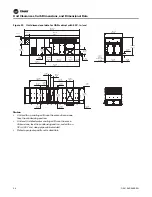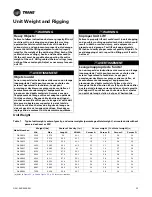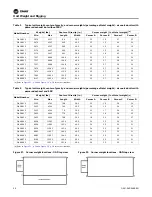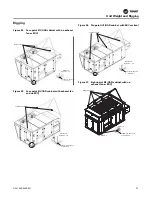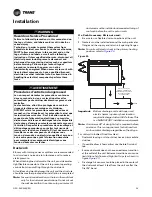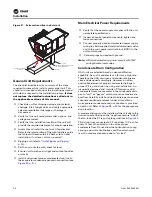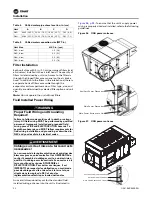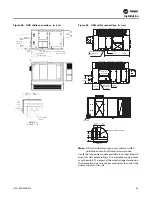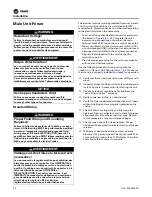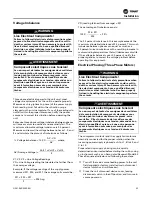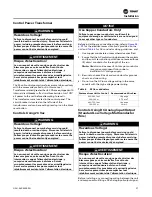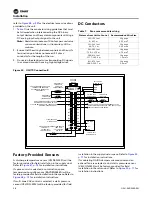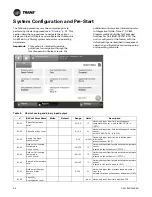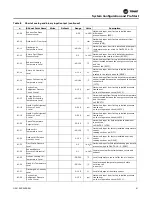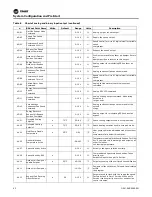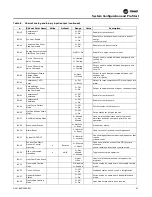
Installation
36
OAU-SVX006E-EN
Compressor Crankcase Heaters
To prevent injury or death from electrocution, it is the
responsibility of the technician to recognize this hazard
and use extreme care when performing service
procedures with the electrical power energized.
Each compressor shall be equipped with a crankcase
heater. The proper operation of the crankcase heater is
important to maintain an elevated compressor oil
temperature during the “Off” cycle to reduce oil foaming
during compressor starts. Oil foaming occurs when
refrigerant condenses in the compressor and mixes with
the oil. In lower ambient conditions, refrigerant migration
to the compressor could increase.
When the compressor starts, the sudden reduction in
crankcase pressure causes the liquid refrigerant to boil
rapidly causing the oil to foam. This condition could
damage compressor bearings due to reduced lubrication
and could cause compressor mechanical failures.
Before initial start up, or if main power has been off for an
extended period of time, compressor crankcase heater(s)
should be operated for a minimum of 8 hours prior to
compressor operation. With main power OFF, remove
jumper between OAUTS terminals 9 and 10 (E-Stop). Turn
main power to energize crankcase heater(s). At end of
warm up period turn main power off, install 9-10 jumper,
turn main power on, and resume normal operation.
Following crankcase heater warm-up, turn main power
disconnect off, and install jumper on E-Stop terminals 9
and 10.
Turn Main disconnect “On”.
Main Unit Display and ReliaTel Controls
When first powered “On”, the controls perform self-
diagnostic initialization to check that all internal controls
are functional. The Status LED located on the Main Unit
Display and the Liteport LED located on the RTRM module
is turned “On” within one second of power-up if internal
operation is okay.
Field-Installed Control Wiring
An overall layout of the various control options available
with the required number of conductors for each control
device is illustrated in
Note:
All field wiring must conform to NEC guidelines as
well as state and local codes.
Observe the ABC and CBA phase indicator lights on
the face of the sequencer. The ABC indicator light will
glow if the phase is ABC. If the CBA indicator light
glows, turn main source power off and then open the
unit main disconnect device cover and reverse any
two power wires.
Restore the main source power and recheck the
phasing. If the phasing is correct, turn main source
power off then open the unit main disconnect device
cover, remove the phase sequence indicator, reinstall
disconnect device cover and, leaving disconnect
device in the off position, turn main power source to
unit on.
WARNING
Live Electrical Components!
Failure to follow all electrical safety precautions when
exposed to live electrical components could result in
death or serious injury. When necessary to work with
live electrical components, have a qualified licensed
electrician or other individual who has been properly
trained in handling live electrical components perform
these tasks.
AVERTISSEMENT
Composants électriques sous tension!
Le non-respect de toutes les consignes de sécurité lors
de la manipulation de composants électriques sous
tension peut entraîner des blessures graves, voire
mortelles. S’il est nécessaire de travailler avec des
composants électriques sous tension, demandez à un
électricien qualifié et agréé ou à une autre personne
ayant la formation nécessaire pour manipuler des
composants électriques sous tension d’exécuter ces
tâches.
WARNING
Proper Field Wiring and Grounding
Required!
Failure to follow code could result in death or serious
injury. All field wiring MUST be performed by qualified
personnel. Improperly installed and grounded field
wiring poses FIRE and ELECTROCUTION hazards. To
avoid these hazards, you MUST follow requirements for
field wiring installation and grounding as described in
NEC and your local/state electrical codes.
AVERTISSEMENT
Câblage sur site et mise à la terre corrects
nécessaires!
Le non-respect de la réglementation peut entraîner des
blessures graves, voire mortelles. Il est IMPÉRATIF d
confier l’ensemble du câblage sur site à un électricien
qualifié. Un câblage sur site mal installé ou mal mis à la
terre constitue des risques D’INCENDIE et
D’ÉLECTROCUTION. Pour éviter ces risques, il est
IMPÉRATIF de respecter les obligations en matière de
pose de câblage sur site et de mise à la terre tel que
stipulé dans les règles du NEC et dans les
réglementations électriques locales/nationales.



